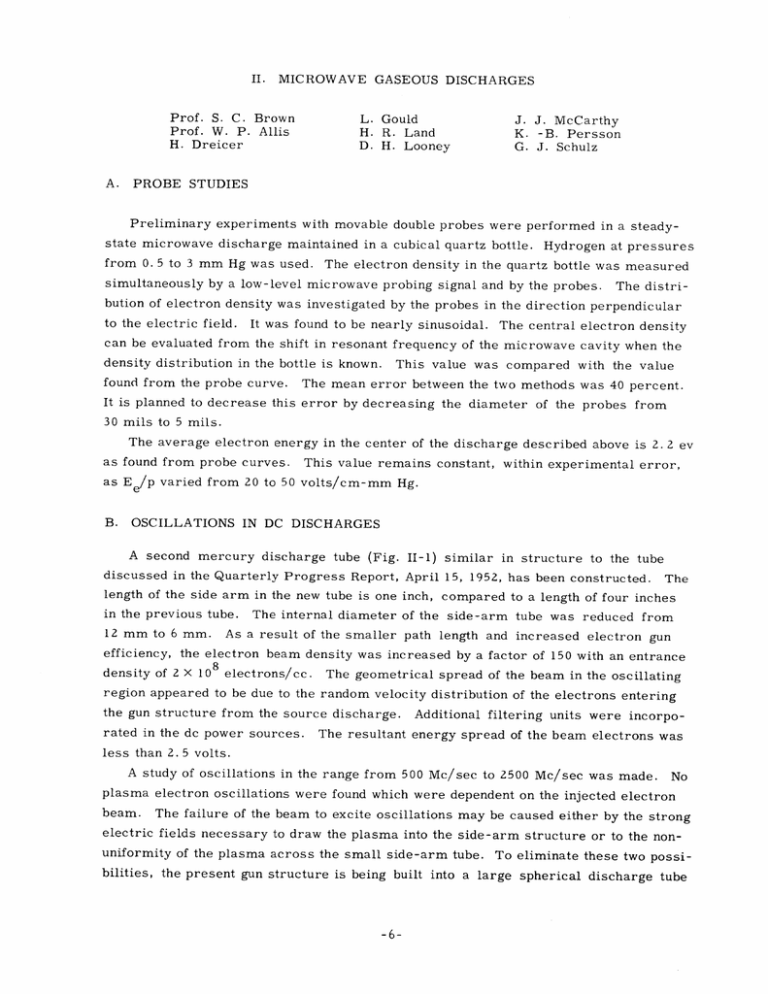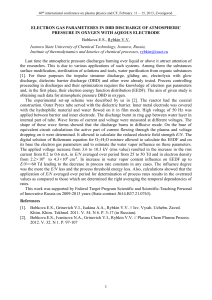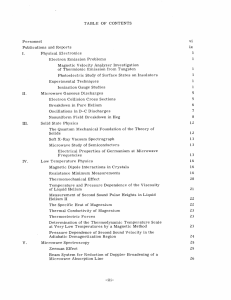II. MICROWAVE GASEOUS DISCHARGES L. Gould
advertisement

II. MICROWAVE Prof. S. C. Brown Prof. W. P. Allis H. Dreicer A. GASEOUS DISCHARGES L. Gould H. R. Land D. H. Looney J. J. McCarthy K. -B. Persson G. J. Schulz PROBE STUDIES Preliminary experiments with movable double probes were performed in a steadystate microwave discharge maintained in a cubical quartz bottle. from 0. 5 to 3 mm Hg was used. Hydrogen at pressures The electron density in the quartz bottle was measured simultaneously by a low-level microwave probing signal and by the probes. The distri- bution of electron density was investigated by the probes in the direction perpendicular to the electric field. It was found to be nearly sinusoidal. The central electron density can be evaluated from the shift in resonant frequency of the microwave cavity when the density distribution in the bottle is known. This value was compared with the value found from the probe curve. The mean error between the two methods was 40 percent. It is planned to decrease this error by decreasing the diameter of the probes from 30 mils to 5 mils. The average electron energy in the center of the discharge described above is 2. 2 ev as found from probe curves. This value remains constant, within experimental error, as Ee/p varied from 20 to 50 volts/cm-mm Hg. B. OSCILLATIONS IN DC DISCHARGES A second mercury discharge tube (Fig. II-1) similar in structure to the tube discussed in the Quarterly Progress Report, April 15, 1952, has been constructed. The length of the side arm in the new tube is one inch, compared to a length of four inches in the previous tube. The internal diameter of the side-arm tube was reduced from 12 mm to 6 mm. As a result of the smaller path length and increased electron gun efficiency, the electron beam density was increased by a factor of 150 with an entrance density of 2 x 108 electrons/cc. The geometrical spread of the beam in the oscillating region appeared to be due to the random velocity distribution of the electrons entering the gun structure from the source discharge. rated in the dc power sources. Additional filtering units were incorpo- The resultant energy spread of the beam electrons was less than 2.5 volts. A study of oscillations in the range from 500 Mc/sec to 2500 Mc/sec was made. No plasma electron oscillations were found which were dependent on the injected electron beam. The failure of the beam to excite oscillations may be caused either by the strong electric fields necessary to draw the plasma into the side-arm structure or to the nonuniformity of the plasma across the small side-arm tube. To eliminate these two possibilities, the present gun structure is being built into a large spherical discharge tube -6- (II. MICROWAVE GASEOUS DISCHARGES) I IN. OSCILLATING REGION Fig. II-1 Low-pressure mercury discharge tube. similar to the tube described in the Quarterly Progress Report, October 15, 1951. In the earlier tube the electron beam emerging from the cathode maintaining the discharge was observed to excite oscillations. The electron beam injected into the plasma by the present gun structure is more flexible in that the electron beam density is independent of the accelerating voltage, and the accelerating voltage can be made much larger than was obtainable from the cathode fall of the low-pressure mercury arc. The cathode maintaining the discharge plasma in the spherical tube will be the same as that in the previous tube. Therefore it will be possible to compare the effects of the two electron beams under identical plasma conditions. -7- (II. C. MICROWAVE GASEOUS DISCHARGES) ELECTRON-ION RECOMBINATION IN HYDROGEN The measurements mentioned in the Quarterly Progress Report, July 15, 1952, were performed in a rectangular cavity with a bottle small in relation to the dimensions of the cavity. The quantity measured by the frequency shift relative to the empty cavity is proportional to E ndv bottle fc E2dv cavi t y When the bottle is small compared with the cavity, this is proportional to ndv 1bottle It is thus obvious that the size of the bottle in relation to the size of the cavity may have a large influence on the behavior of the measured quantity. A careful analysis shows that with the proper choice of bottle dimensions it is possible to minimize the contribution from higher diffusion modes to the measured quantity. Preliminary experiments indicate the validity of the analysis. been constructed. In order to emphasize this effect, a new cavity has The wall of the cavity is slit along one axis and a photomultiplier moves back and forth along that slit measuring the light intensity as a function of position. In the afterglow, however, only the light intensity decay at a fixed position can be measured. In order to obtain reproducible electron density decay curves it is essential to maintain a symmetric discharge. Asymmetries of the electron density distribution in the bottle are shown in the distribution of light intensity as a function of position. These can be eliminated by adjustment of the microwave circuit parameters. -8-



